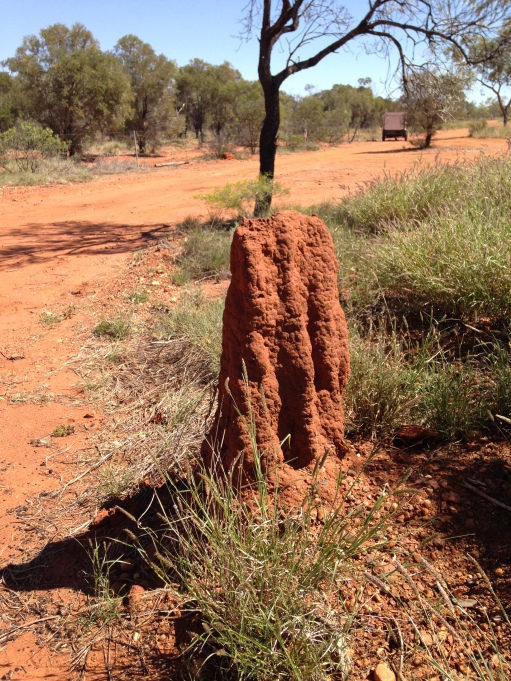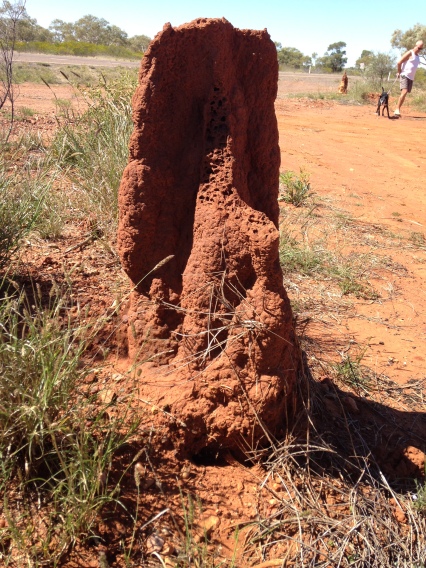
Termite mound western Queensland
And Outback Australia is full of it! Except of course, in the wet season when it becomes mud – glorious mud. From the ubiquitous bull-dust liberally lacing dry Outback humour, to the fine dust of the ancient millennia from which we all rise and eventually return, in a constant recycling of universal matter.
One of the first things I noticed while exploring the Outback, was the intense colour of the dirt. In my ignorance I hesitated to call it soil at the time, so denuded it seemed of any nutrient value. Its colour really is bright red or vibrant orange and occasionally a darker loamy hue. Looking around, one can’t help marvelling at the diversity of life, both flora and fauna, that it supports. Despite the harsh climate, plants and other life forms can, and do, thrive here.
As we travelled across the landscape I was fascinated to see red sentinels, sometimes in their hundreds, beside the highways and stretching off into the distance. Closer inspection revealed them as termite mounds of all shapes and sizes. It turns out that the termites that often cause havoc for suburban homeowners have cousins that are an important part of the Australian soil ecology, a part of the infinite web of life.

Roadside termite mound which potentially may hold hundreds of thousands of termites in subterranean tunnels as deep as 100 metres.
‘Australia’s outback is characterised by minimal rainfall and nutrient deficient soils, which has led to slow nutrient cycling between plants and soils. Termites have adapted to this climate in astounding ways, particularly by their role as decomposers. Their symbiotic relationship with intestinal protozoa and bacteria allows them to digest grass, wood, and other debris. Termites are also capable of forming new soil.’ (ref).
Who would have thought it?
Was this very same soil a recycled version of the ancient Eromanga Sea that covered much of what is now arid inland Australia, some one hundred and ten million years ago? The soil and rock stratum of the rich fossil fields of this region are giving up their secrets, helping us to understand our natural history; the ‘dust’ from which we have come.
There are numerous opportunities for amateurs to join the palaeontological digs on the fossil fields of outback Queensland. I have it on my bucket list. Some of the most exciting finds have been made by station managers out mustering cattle, like the Ievers brothers at Marathon Station, a 22,662 ha cattle and sheep run between Richmond and Hughenden.
I spent hours poring over the fossil records and specimens at Kronosaurus Korner, a wonderful museum in the small town of Richmond. Minmi Paravertebra pictured below is displayed there and was found on the Marathon Station.
I struggled to even imagine a time-span of one hundred and ten million years, and was overwhelmed by my proximity to something so incredibly ancient as these fossils.
I wondered at that point about the dust that continually clogged my nasal passages, that seeped into every crook and cranny of our camper-van, that we probably ate with our porridge.
The less well preserved bones of ancient creatures, perhaps? Our ancestors even?
I doubt I will ever think about dirt or dust in quite the same way again.
Inspiration for this post originates with the phrase “‘From Ashes to ashes, dust to dust’ and comes from the funeral service in the Book of Common Prayer, and it is based on Genesis 3:19, Genesis 18:27, Job 30:19, and Ecclesiastes 3:20. Those passages say that we begin and end as dust. Where did the ashes come from? The compilers of the Book of Common Prayer were careful to produce what is called metrical text—text that when a congregation reads it, it all comes out even. So they pulled in Genesis 18:27 and Job 30:19, in which dust and ashes are both components of the human body. It’s also in Sirach 10:9 in the Apocrypha. (Sirach is also known as Ecclesiasticus.)” ref



Wow, Robyn! Such a very intellectual post this time – wonderful.
LikeLiked by 1 person
Thanks Karolyn! I’m glad you enjoyed it. The Outback has so much to offer, great for stimulating thought.
LikeLike
So termites are like parrot fish, who eat coral and poop out a beach? Fascinating. Loved the post, Robyn!
LikeLiked by 1 person
Haha! That’s pretty much it Marina. Truly amazing when you think about how much these creepy crawlies contribute. We all dread termite infestations in our houses but without them we’d be drowning in waste and would be without useful soil.
LikeLiked by 2 people
A masterful summary! My sister and her family used to live in this area so I’ve seen that red dust in the dry and in the wet. Prefer the dry!
LikeLiked by 1 person
What a privilege Rachel! It has taken me too many years to have finally seen this amazing country. I can’t say as I am keen to visit in the wet season either having been told by others how tough it can be. I wonder what took your sister and her family to the Outback to live? Thanks for taking time to comment.
LikeLiked by 1 person
Here’s their story. My parents were living in Sydney. A high school romance. A land ballot. Done!
LikeLiked by 1 person
great post. love the termite mound photos
LikeLike
Aren’t they fantastic structures? In places they are so dense it appears there’s little room for the cattle to graze. Further north the mounds become bigger – as high as two metres. I’m glad you enjoyed the photos Brenda.
LikeLike
An amazing post Robyn! Many interesting and intriguing things to discover.
LikeLiked by 1 person
Thank you Lyn. I’m glad you found it interesting.
LikeLiked by 1 person
Very interesting for sure! Something I have never seen before!
LikeLike
I do love to read your blog when I can Robyn. You have such wonderful insights and information. I agree that we are all part of the Universe. Came from, exist as part of, will eventually return to, to come forth once again as another form, even if as only a rock. Also, the ants creating soil. Our dead skin, nail clippings, hair follicles, and, once we pass on as humans, all form soil one way or another. Even if we are eaten by tigers. Then absorbed by trees. The same way that some sand is made of tiny broken crustacean shells. Eaten alive, as coral, by parrot fish. Death can give life. Destruction can lead to creation.
LikeLiked by 1 person
Thank you Sime! I’m so pleased you visited my blog and that we two share a part, albeit tiny, of the great Web of Life together. I hope your studies are going well for you.
LikeLiked by 1 person
Thank-you 🙂 By the way . . I have changed my degree, from Psychology to a BA in Humanities: Securities Studies + International and Political Studies. World events really — refugees, famine, ‘terrorism’, human rights, animal rights, war, TPP, UN, economics, injustice, all the stuff I read in books these days (even though I don’t have time to read outside of Uni material – still haven’t finished ‘Scientific Revolutions’ – then again, my Uni material is quite stimulating and when I write essays now, I get to choose the subject) . . humanities is more ‘hands on’ so far . . eventually I would like to work for Amnesty, Red Cross, or some sort of NGO, maybe become an international correspondent journalist. I only just ‘followed’ you now but I have been reading your posts via email 🙂
LikeLiked by 1 person
I’m excited for you! You have discovered your passion. I look forward to hearing about your progress. Thanks for taking time to read my blog.
LikeLike
Those termite mounds are amazing – a universe in themselves! And the colour is incredible. The outback is such a contrast to our coast life on the fringe of the continent. I bet you were shaking the dust off for days after getting back 🙂
LikeLiked by 1 person
The dust invaded every nook and cranny! It was up our noses and I was tasting it for days. I was fascinated by the mounds and the role they play in nature.
LikeLiked by 1 person
😀 gosh! tasting it too!
LikeLike
And this after the good rains they’d had just some weeks prior to our visit. Can you imagine how it must be during the drought? In Mount Isa, the dust contains heavy metals like lead, from the mine. I tried to avoid breathing there but thinking about the consequences of taking that measure forced me to begin again.
LikeLike
A closer look (of anything, really) can reveal hidden jems 🙂 By the way, I really like your slideshow galleries in the footer area! Great idea!
LikeLiked by 1 person
I’m never short of shots I’d like to share so that was a feature of WordPress that could show them off. Glad you like them.
LikeLiked by 1 person